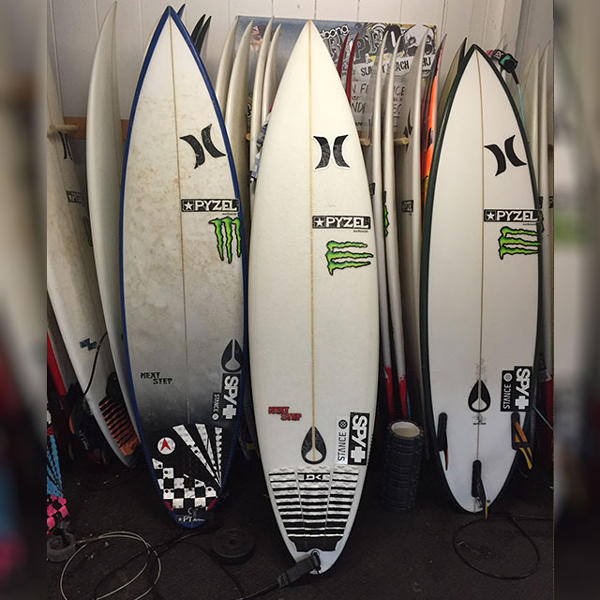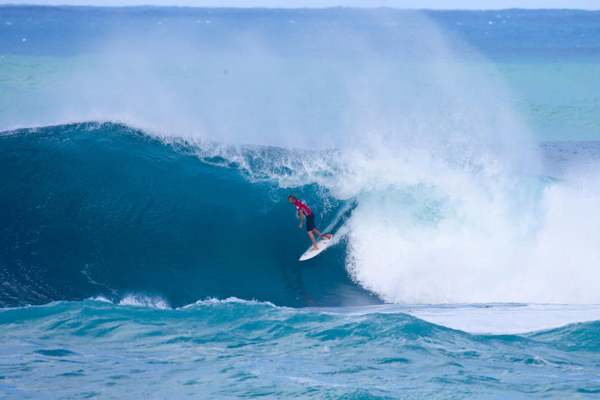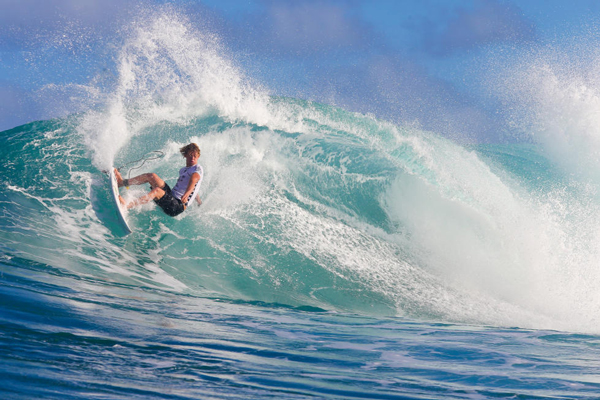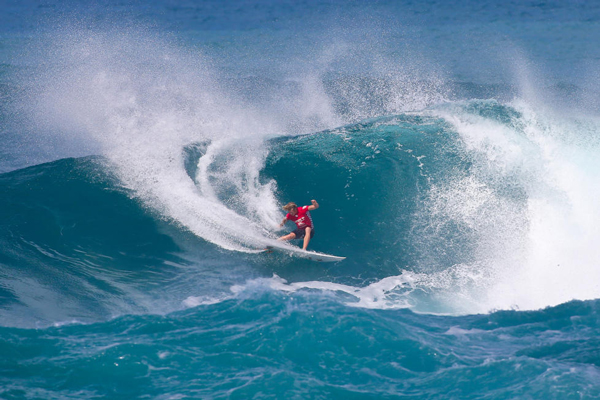
John John Florence was on a tear at Vans World Cup of Surfing at Sunset Beach, riding a board upwards of a foot shorter than most. Directly after the event we caught up with JJ’s shaper Jon Pyzel to get the scoop on his magic sword:
REAL:
Tell us about John’s Sunset board. What model is it and what’s the construction?
Jon Pyzel:
6-4 x 18.65 x 2.38 Next Step. PU Arctic foam blank, 6 oz bottom, double 4oz deck, Futures Tri Fin with JJF Medium Futures Fins. The Next Step is a step-up board that I have refined every year for the past 5 or so years, and it’s the model that I make for all the my team guys, and the guys who come over here and order boards for good, bigger waves. It has a little more volume in the forward half of the board, and everyone tells me that they really like how that gives them a lot of confidence with the paddle power and feels good in powerful surf. I put quite a lot of rocker in these boards and some double concave through the bottom to let them tip onto the rail really easily at high speeds. The tails are all round pins, but not super pulled in, so they don’t feel too “gunny” and stiff. My goal with these boards is for the surfer to be able to feel like they are on a shortboard, but one that will handle in solid waves.
I typically make JJ the Next Step in 6’2”, 6’4”, 6’6” and 6’8”. He also always has a giant pile of 6’0”s and 6’1”s that are always in rotation, almost all the Bastard model, which is his favorite shortboard at the moment. These will be squashes and round tails, and he will have a few set aside as contest only boards and the rest are his freesurf boards, the boards he surfs everyday.
REAL:
Did you make this board specifically for Sunset or is this something John rides all over the North Shore (and the world)?
Jon Pyzel:
I make the Next Step for everywhere. This is a board that JJ has won Sunset and Pipe contests on, as well as riding it at all the Fiji and Tahiti events. Sally Fitz won Fiji on this design this year too (the Firewire version).
REAL:
The talk of the Sunset contest was BIG BOARDS. The WSL commentators probably said BIG BOARDS or BIGGER BOARDS over a hundred times during the course of the event. Why did John decide to go with a board that was so much smaller than most?
Jon Pyzel:
2 reasons– his game plan and his ability! The best waves in the event were the medium ones, not the sets, so JJ was looking for those and he know that his 6’4” would handle those size waves perfectly. And he just surfs so good that he can get away with less foam under his feet which lets him put the board on rail and hold it there really well.

REAL:
Does JJF even have boards sized into the range most competitors were using during the Sunset event, or does he skip straight to 9-10′ boards above 6’6 or something?
Jon Pyzel:
His quiver skips from 6’8” to 9’0” (actually I think he has a beefy 8’6” stashed on Tavarua in case it got huge again during an event there). He just approaches waves a little different than most people. The larger boards in his quiver are for really big surf. These are for Waimea, Jaws, and all the Outer Reef waves we have over here. That quiver is all a board that Mark Healey and I developed together that I call the Crazy Train. JJ’s Crazy Train quiver is 9’0”, 9’6”, 9’8” and 2x 10’5”. These are all very wide, thick beasts that should let him get into any wave he wants to catch. The 9’6” and 9’8” are more Waimea boards, super beefy, but shorter to fit into the curve on the face at the Bay. The 10’5”s are more open ocean kind of boards that will help you get in earlier and safe. These are all quads.
REAL:
When you know a shorter board like this will be ridden in surf of this size, what design parameters are tweaked if any to help improve control and performance?
Jon Pyzel:
The design of the Next Step has a more pulled in outline and more rocker to help keep it in control, yet loose and free like a shortboard. I want the surfer to be able to push that board as hard as they can and not feel like they have to hold anything back.

Photo: WSL / Laurent Masurel
REAL:
In one of JJFs heats he got more good waves than the rest of his heat’s surfers combined. Was that sheer luck, lineup skill or something to do with his board choice?
Jon Pyzel:
That was his 1/4 final, and he just got on a roll where he was in the right spot for a lot of waves. He gets so stoked when the waves are good that he can’t help himself, he just wants to get another good one (just like all of us, except he gets to surf places with only a couple guys out).

REAL:
What’s the typical dialogue between you and JJ with regards to how the boards are working and what changes he wants?
Jon Pyzel:
John is great with feedback because he feels really small changes in boards that a lot of guys might not even notice. He isn’t really a numbers guy. Like, he’s not telling me thicknesses or widths that he wants, but he can pick apart a certain “feel’ or he will show me a clip of something he notices that the boards are doing weird and I can make adjustments to the boards from there. He has a good idea of what he wants a board to feel like, and when we are chasing something new he always has good ideas and great instincts. He’s plugged in, for sure.
REAL:
Most of the world agrees that John John is one of, if not the best surfer in the world. Many times, he’s defeated by an older, more seasoned competitor, that proves that they are better at winning contests. What will it will take John to cross the threshold from being the “best surfer” to the best surfer with the competitive savvy to win a world championship?
Jon Pyzel:
He is really watching how guys are winning their heats these days, and taking that information and using it in his own heats. Making “View from a Blue Moon” took up a lot of his time and focus over the past few years, and now that it is finished I think we are going to see him competing at a higher level.
View our full selection of Pyzel Surfboards.


